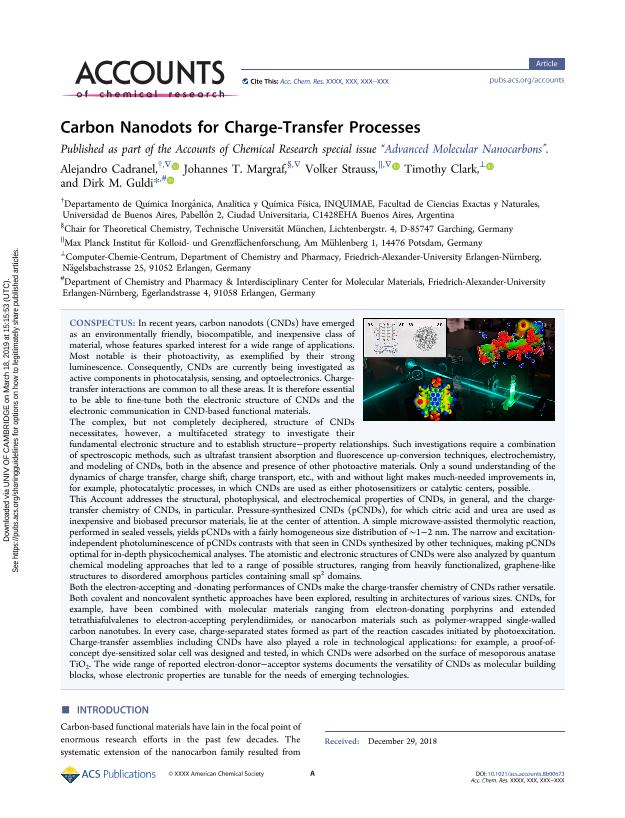Mostrar el registro sencillo del ítem
dc.contributor.author
Cadranel, Alejandro

dc.contributor.author
Margraf, Johannes T.
dc.contributor.author
Strauss, Volker
dc.contributor.author
Clark, Timothy
dc.contributor.author
Guldi, Dirk M.
dc.date.available
2021-01-25T15:40:13Z
dc.date.issued
2019-12
dc.identifier.citation
Cadranel, Alejandro; Margraf, Johannes T.; Strauss, Volker; Clark, Timothy; Guldi, Dirk M.; Carbon Nanodots for Charge-Transfer Processes; American Chemical Society; Accounts of Chemical Research; 52; 4; 12-2019; 955-963
dc.identifier.issn
0001-4842
dc.identifier.uri
http://hdl.handle.net/11336/123590
dc.description.abstract
In recent years, carbon nanodots (CNDs) have emerged as an environmentally friendly, biocompatible, and inexpensive class of material, whose features sparked interest for a wide range of applications. Most notable is their photoactivity, as exemplified by their strong luminescence. Consequently, CNDs are currently being investigated as active components in photocatalysis, sensing, and optoelectronics. Chargetransfer interactions are common to all these areas. It is therefore essential to be able to fine-tune both the electronic structure of CNDs and the electronic communication in CND-based functional materials. The complex, but not completely deciphered, structure of CNDs necessitates, however, a multifaceted strategy to investigate their fundamental electronic structure and to establish structure−property relationships. Such investigations require a combination of spectroscopic methods, such as ultrafast transient absorption and fluorescence up-conversion techniques, electrochemistry, and modeling of CNDs, both in the absence and presence of other photoactive materials. Only a sound understanding of the dynamics of charge transfer, charge shift, charge transport, etc., with and without light makes much-needed improvements in, for example, photocatalytic processes, in which CNDs are used as either photosensitizers or catalytic centers, possible. This Account addresses the structural, photophysical, and electrochemical properties of CNDs, in general, and the chargetransfer chemistry of CNDs, in particular. Pressure-synthesized CNDs (pCNDs), for which citric acid and urea are used as inexpensive and biobased precursor materials, lie at the center of attention. A simple microwave-assisted thermolytic reaction, performed in sealed vessels, yields pCNDs with a fairly homogeneous size distribution of ∼1−2 nm. The narrow and excitationindependent photoluminescence of pCNDs contrasts with that seen in CNDs synthesized by other techniques, making pCNDs optimal for in-depth physicochemical analyses. The atomistic and electronic structures of CNDs were also analyzed by quantum chemical modeling approaches that led to a range of possible structures, ranging from heavily functionalized, graphene-like structures to disordered amorphous particles containing small sp2 domains. Both the electron-accepting and -donating performances of CNDs make the charge-transfer chemistry of CNDs rather versatile. Both covalent and noncovalent synthetic approaches have been explored, resulting in architectures of various sizes. CNDs, for example, have been combined with molecular materials ranging from electron-donating porphyrins and extended tetrathiafulvalenes to electron-accepting perylendiimides, or nanocarbon materials such as polymer-wrapped single-walled carbon nanotubes. In every case, charge-separated states formed as part of the reaction cascades initiated by photoexcitation. Charge-transfer assemblies including CNDs have also played a role in technological applications: for example, a proof-ofconcept dye-sensitized solar cell was designed and tested, in which CNDs were adsorbed on the surface of mesoporous anatase TiO2. The wide range of reported electron-donor−acceptor systems documents the versatility of CNDs as molecular building blocks, whose electronic properties are tunable for the needs of emerging technologies.
dc.format
application/pdf
dc.language.iso
eng
dc.publisher
American Chemical Society

dc.rights
info:eu-repo/semantics/openAccess
dc.rights.uri
https://creativecommons.org/licenses/by-nc-sa/2.5/ar/
dc.subject
CARBON NANODOTS
dc.subject
CHARGE TRANSFER
dc.subject.classification
Físico-Química, Ciencia de los Polímeros, Electroquímica

dc.subject.classification
Ciencias Químicas

dc.subject.classification
CIENCIAS NATURALES Y EXACTAS

dc.title
Carbon Nanodots for Charge-Transfer Processes
dc.type
info:eu-repo/semantics/article
dc.type
info:ar-repo/semantics/artículo
dc.type
info:eu-repo/semantics/publishedVersion
dc.date.updated
2020-11-20T14:50:26Z
dc.journal.volume
52
dc.journal.number
4
dc.journal.pagination
955-963
dc.journal.pais
Estados Unidos

dc.journal.ciudad
Washington
dc.description.fil
Fil: Cadranel, Alejandro. Universidad de Buenos Aires. Facultad de Ciencias Exactas y Naturales. Departamento de Química Inorgánica, Analítica y Química Física; Argentina. Consejo Nacional de Investigaciones Científicas y Técnicas. Oficina de Coordinación Administrativa Ciudad Universitaria. Instituto de Química, Física de los Materiales, Medioambiente y Energía. Universidad de Buenos Aires. Facultad de Ciencias Exactas y Naturales. Instituto de Química, Física de los Materiales, Medioambiente y Energía; Argentina
dc.description.fil
Fil: Margraf, Johannes T.. Technische Universitat München; Alemania
dc.description.fil
Fil: Strauss, Volker. No especifíca;
dc.description.fil
Fil: Clark, Timothy. Universitat Erlangen-Nuremberg; Alemania
dc.description.fil
Fil: Guldi, Dirk M.. Universitat Erlangen-Nuremberg; Alemania
dc.journal.title
Accounts of Chemical Research

dc.relation.alternativeid
info:eu-repo/semantics/altIdentifier/url/http://pubs.acs.org/doi/10.1021/acs.accounts.8b00673
dc.relation.alternativeid
info:eu-repo/semantics/altIdentifier/doi/http://dx.doi.org/10.1021/acs.accounts.8b00673
Archivos asociados
